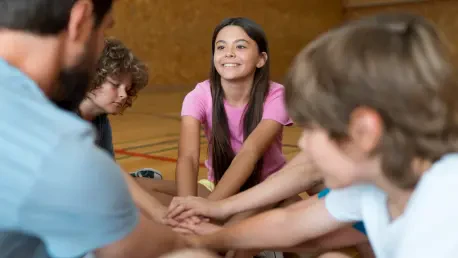In a world where students spend an alarming average of over seven hours a day staring at screens, a refreshing counter-movement is gaining traction in education, urging a pivot from digital overload to the rejuvenating embrace of nature, often dubbed “green time.” This shift isn’t merely about cutting down on device use; it’s a deliberate effort to leverage outdoor environments to enhance mental health, sharpen academic focus, and nurture overall well-being among young learners. Schools across regions like Maine are at the forefront, embedding outdoor experiences into their daily schedules as a potential antidote to the stress and disconnection fostered by constant technology exposure. The question looms large: can consistent time in green spaces fundamentally alter how students feel, behave, and succeed in their educational journeys? This exploration delves into the transformative potential of nature in schools, examining its impact on emotional resilience, learning engagement, and equitable access to natural spaces, while weighing the challenges of making such programs a widespread reality.
Nature’s Restorative Impact on Young Minds
The profound effect of nature on mental and physical health is increasingly backed by solid research, offering a compelling case for integrating outdoor time into school routines. Theories such as Attention Restoration and Stress Reduction highlight how exposure to natural settings can significantly lower anxiety levels, boost concentration, and elevate mood among students. Experts from institutions like North Carolina State University emphasize that even minimal encounters with nature—think a lone tree on a school sidewalk or a small garden patch—can yield substantial benefits. This challenges the misconception that only expansive wilderness areas can deliver therapeutic effects. For students grappling with the pressures of modern life, from academic stress to social challenges, these small doses of greenery provide a vital reprieve, acting as a natural buffer against mental fatigue and emotional strain. The evidence suggests that schools embracing this approach could see a marked improvement in student demeanor and readiness to learn, setting a foundation for healthier classroom dynamics.
Beyond the academic theories, tangible outcomes from real-world applications further validate nature’s role in student well-being. Schools that have prioritized outdoor breaks or activities report noticeable shifts in how students return to their desks—often calmer, more attentive, and less agitated. This isn’t just anecdotal; it aligns with broader observations of rising mental health concerns among youth, exacerbated by relentless technology use and sedentary indoor lifestyles. Unlike the overstimulation of screens, nature offers a gentle, grounding experience that helps reset overworked minds. For many educators, this has become a practical tool to address issues like classroom restlessness or emotional outbursts, providing a non-invasive way to support students who might otherwise struggle. As mental health challenges continue to climb in educational settings, embedding green time into the school day emerges as a proactive strategy, not just a luxury, but a necessity for fostering a balanced and supportive learning environment.
Reimagining Education Through Outdoor Classrooms
Innovative schools are redefining the traditional classroom by integrating outdoor spaces into core academic curricula, creating dynamic learning environments that resonate with students. In Maine, for example, educational institutions like Limestone Community School have pioneered programs where middle-grade students engage in activities such as mountain biking or snowshoeing, seamlessly linking these experiences to lessons in subjects like mathematics and science. Similarly, the Maine Academy of Natural Sciences immerses its students in practical tasks involving greenhouses and beekeeping, blending environmental education with standard academic goals. These initiatives go beyond mere physical exercise; they contextualize abstract concepts in real-world settings, making learning more relatable and memorable. The result is a student body that shows heightened interest and participation, often discovering passions or skills that extend far beyond the schoolyard. This approach signals a shift toward experiential education, where nature becomes an active partner in teaching.
The benefits of such outdoor learning programs extend into measurable academic and behavioral improvements, underscoring their potential to revolutionize educational practices. Students involved in these nature-based activities frequently exhibit better attendance records and more positive classroom interactions, as reported by educators in pioneering schools. Engagement isn’t the only gain; the hands-on nature of these lessons fosters critical thinking and problem-solving skills, equipping students for lifelong learning. However, implementing these programs isn’t without hurdles—funding constraints and logistical issues often limit their scope, especially in resource-strapped districts. Despite these challenges, the success of early adopters suggests that outdoor classrooms could become a cornerstone of modern education if supported by strategic investments and policy adjustments. By transforming school grounds into active learning hubs, educators can craft a more engaging and holistic academic experience, proving that education doesn’t always need four walls to thrive.
Addressing Inequity with Green School Spaces
Access to nature remains starkly unequal across communities, with low-income and minority areas disproportionately affected by what’s known as the “nature gap,” a disparity that schools are uniquely positioned to address. Striking statistics reveal that 74% of communities of color and 70% of low-income neighborhoods lack nearby green spaces, in sharp contrast to just 23% of predominantly white areas. This inequity deprives many children of nature’s proven health and developmental benefits, perpetuating cycles of disadvantage in well-being and opportunity. For students in urban or underprivileged settings, the absence of parks or natural areas near home means that school might be their only chance to experience greenery. This reality places educational institutions at the heart of a potential solution, offering a platform to level the playing field by ensuring that all children, regardless of background, can reap the restorative rewards of outdoor time during their formative years.
Turning school grounds into green havens offers a practical and scalable way to bridge this nature gap, with far-reaching implications for equity in education and health. Advocates argue that since nearly every child attends school, transforming campuses into accessible natural spaces—through green schoolyards or outdoor learning zones—could guarantee universal exposure to nature’s benefits. Such initiatives could include simple additions like tree-lined courtyards or community gardens, which don’t require vast resources but can still make a significant impact. Voices from organizations like the Center for American Progress stress that these efforts are not just about recreation but about justice, ensuring underserved students aren’t left behind in accessing environments that support mental and emotional growth. While urban challenges like limited space or environmental heat islands pose obstacles, innovative design and community partnerships can help overcome them, making schools pivotal in dismantling barriers to nature and fostering a more inclusive approach to student well-being.
Balancing Digital Overload with Natural Renewal
The pervasive issue of excessive screen time, often surpassing seven hours daily for many students, has been linked to heightened stress, sensory overload, and diminished mental clarity, creating an urgent need for alternatives like green time. Digital devices, while integral to modern learning, often leave young minds overwhelmed, contributing to issues like anxiety and reduced attention spans. In contrast, time spent outdoors provides a counterbalance, offering a restorative effect that refreshes cognitive functions and eases emotional tension. Schools experimenting with nature-based programs have noted that these activities serve as a natural detox from technology’s constant stimulation. Some have even paired green time with policies limiting cell phone use during school hours, amplifying the focus on real-world engagement. This dual approach highlights a growing recognition that reducing digital dependency requires not just restrictions but meaningful substitutes that captivate students’ attention in healthier ways.
Observations from schools implementing outdoor initiatives reveal an intriguing byproduct: a natural decline in students’ reliance on devices during the school day. Educators in regions like Maine have shared that when students are immersed in engaging activities—whether it’s exploring a trail or tending to a school garden—their impulse to reach for phones diminishes significantly. This shift isn’t forced but organic, suggesting that green time can foster behavioral changes without the need for strict enforcement. It points to a deeper potential for nature to cultivate mindfulness and presence among students, countering the fragmented attention often induced by screens. As technology continues to dominate daily life, these findings underscore the value of outdoor programs as a tool to restore balance, not by rejecting digital tools outright but by integrating natural experiences that encourage healthier habits and a more grounded approach to learning and interaction.
Paving the Way for a Greener Educational Future
Reflecting on the journey of integrating green time into school systems, it’s evident that past efforts have laid a robust groundwork for enhancing student well-being through nature. Schools in areas like Maine have demonstrated how outdoor programs, once supported by temporary funding, improved mental health outcomes and academic engagement among diverse student populations. The documented success in reducing screen dependency and addressing behavioral challenges through nature-based activities highlights a path worth pursuing. Legislative backing in states such as Minnesota and Oregon, which have previously prioritized outdoor education, shows that policy can amplify these initiatives, embedding them into the fabric of public education. Even amidst hurdles like funding cuts after temporary relief periods, the momentum built by early adopters provides valuable lessons on resilience and adaptation, proving that small, intentional steps toward green integration yield outsized benefits for student communities.
Looking ahead, the focus must shift to actionable strategies that sustain and expand green time in schools, ensuring its benefits reach every student. Policymakers and educators should prioritize securing consistent funding streams, perhaps through public-private partnerships or grants, to maintain outdoor programs beyond short-term budgets. Urban schools, often constrained by space, could explore innovative designs like rooftop gardens or collaborations with local parks to create accessible natural areas. Additionally, teacher training programs should incorporate outdoor education modules to build capacity among staff, addressing shortages and curriculum rigidity. States planning recommendations, such as Maine’s upcoming framework expected by 2026, offer a blueprint for cost-effective integration that others can replicate. By championing green schoolyards as a universal right, not a privilege, and leveraging community support, the educational landscape can evolve into one where nature is a core pillar of student growth, promising a healthier, more connected generation.









